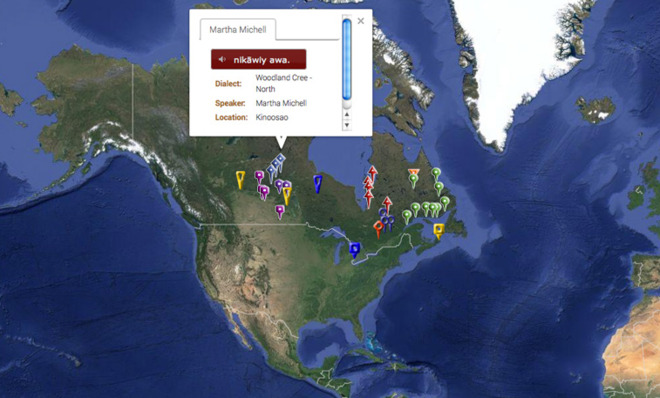Fun with the interactive Algonquian language map
If you don't know your Plains Cree from your Innu, this map can help


There was once a linguistic landscape of incredible diversity in North America. While the continent of Europe has three main language families — Romance, Germanic, and Slavic — Native American languages can be grouped into about 30 language families. One of the largest, with languages that at one time covered an area reaching all the way from New England to the Rocky Mountains, is the Algonquian family. Algonquian languages are still spoken in Canada and the northern U.S. Two of them — Cree and Ojibwa — are estimated to have over 50,000 speakers. But even the healthiest native languages need active support to ensure their survival.
The goal of the Algonquian Linguistic Atlas is "to make sure that the beautiful Algonquian languages and the cultures they embody will be heard and spoken by many more generations to come." It isn't just a repository of words and stories though. It is organized in a way that lets you explore the similarities and differences between the languages, and see how they are distributed by place.
On the upper right of the map are two pulldown menus that let you choose a particular word from a range of categories (family members, days of the week, numbers…) or even whole sentences ("Did your son see that canoe?" "You guys eat those apples now.") Then you can click a pin on the map to see what that word or phrase is in different Algonquian languages.
The Week
Escape your echo chamber. Get the facts behind the news, plus analysis from multiple perspectives.

Sign up for The Week's Free Newsletters
From our morning news briefing to a weekly Good News Newsletter, get the best of The Week delivered directly to your inbox.
From our morning news briefing to a weekly Good News Newsletter, get the best of The Week delivered directly to your inbox.
For example, here are some words for "one":
Plains Cree: piyak
Swampy Cree: pēyik
East Cree: paayikw
A free daily email with the biggest news stories of the day – and the best features from TheWeek.com
Métis Cree/Michif (A mix of Cree and French): en or pêyak
Algonquin: pejig
Innu: peikw
Nishnaabemwin: bezhig
Mi'kmaw: ne'wt
Looking at these words in groups gets you to start asking the kinds of questions linguists like to ask when researching the history of languages. Can these all be traced back to a common proto-word? Why did "p" become "b" in Nishnaabemwin? Why is Mi'kmaw so different? The answers are clues to the mixing and movement of people over centuries.
At the bottom of the map, the "Classroom" button brings up simple worksheets for learning to spot sound differences. The whole site is a simple, clear and fascinating way to get in touch with the linguistic history of our continent. Learn and enjoy here.
Arika Okrent is editor-at-large at TheWeek.com and a frequent contributor to Mental Floss. She is the author of In the Land of Invented Languages, a history of the attempt to build a better language. She holds a doctorate in linguistics and a first-level certification in Klingon. Follow her on Twitter.
-
 5 loony toons about the Warner Bros. buyout
5 loony toons about the Warner Bros. buyoutCartoons Artists take on movie theaters, high quality cinema, and more
-
 Political cartoons for December 13
Political cartoons for December 13Cartoons Saturday's political cartoons include saving healthcare, the affordability crisis, and more
-
 Farage’s £9m windfall: will it smooth his path to power?
Farage’s £9m windfall: will it smooth his path to power?In Depth The record donation has come amidst rumours of collaboration with the Conservatives and allegations of racism in Farage's school days
